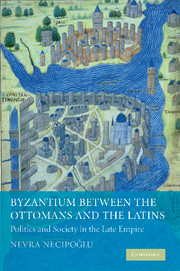Book contents
- Frontmatter
- Contents
- List of maps
- Acknowledgements
- Note on transliteration
- List of abbreviations
- Map 1 The Byzantine world in the fourteenth–fifteenth centuries
- Map 2 Byzantium and its neighbors, c. 1350
- Map 3 Byzantium and its neighbors after 1402
- PART I INTRODUCTION AND POLITICAL SETTING
- PART II THESSALONIKE
- PART III CONSTANTINOPLE
- 6 The Byzantine court and the Ottomans: conflict and accommodation
- 7 The first challenge: Bayezid I's siege of Constantinople (1394–1402)
- 8 From recovery to subjugation: the last fifty years of Byzantine rule in Constantinople (1403–1453)
- PART IV THE DESPOTATE OF THE MOREA
- Conclusion
- Appendix I Archontes of Thessalonike (fourteenth—fifteenth centuries)
- Appendix II “Nobles” and “small nobles” of Thessalonike (1425)
- Appendix III Constantinopolitan merchants in Badoer's account book (1436–1440)
- Appendix IV Members of the Senate of Constantinople cited in the synodal tome of August 1409
- Appendix V Some Greek refugees in Italian territories after 1453
- Bibliography
- Index
8 - From recovery to subjugation: the last fifty years of Byzantine rule in Constantinople (1403–1453)
Published online by Cambridge University Press: 07 December 2009
- Frontmatter
- Contents
- List of maps
- Acknowledgements
- Note on transliteration
- List of abbreviations
- Map 1 The Byzantine world in the fourteenth–fifteenth centuries
- Map 2 Byzantium and its neighbors, c. 1350
- Map 3 Byzantium and its neighbors after 1402
- PART I INTRODUCTION AND POLITICAL SETTING
- PART II THESSALONIKE
- PART III CONSTANTINOPLE
- 6 The Byzantine court and the Ottomans: conflict and accommodation
- 7 The first challenge: Bayezid I's siege of Constantinople (1394–1402)
- 8 From recovery to subjugation: the last fifty years of Byzantine rule in Constantinople (1403–1453)
- PART IV THE DESPOTATE OF THE MOREA
- Conclusion
- Appendix I Archontes of Thessalonike (fourteenth—fifteenth centuries)
- Appendix II “Nobles” and “small nobles” of Thessalonike (1425)
- Appendix III Constantinopolitan merchants in Badoer's account book (1436–1440)
- Appendix IV Members of the Senate of Constantinople cited in the synodal tome of August 1409
- Appendix V Some Greek refugees in Italian territories after 1453
- Bibliography
- Index
Summary
The last fifty years of Constantinople under Byzantine rule constitute a critical period during which the city's inhabitants survived two Ottoman sieges (in 1411 and 1422) and, before finally succumbing to a third one in 1453, faced the union of their Church with the Church of Rome at the Council of Florence in 1439. The Union of Florence became the source of much controversy in the city and led to divisions among the population. That dissensions persisted among the citizens to the very last moment is indicated by Doukas, who reports that when Mehmed II's forces appeared before the Byzantine capital in 1453 a group of Constantinopolitans exclaimed in despair, “Would that the City were delivered into the hands of the Latins, who call upon Christ and the Mother of God, and not be thrown into the clutches of the infidel,” while others contradicted them by declaring, “It would be better to fall into the hands of the Turks than into those of the Franks.” Although the union of the Churches was essentially a religious matter, reactions to it were not determined solely by people's religious views. Rather they were expressions of overall attitudes towards the Latins and the Ottomans, which in turn had been shaped by a set of political, social, and economic factors predating the Council of Florence.
- Type
- Chapter
- Information
- Byzantium between the Ottomans and the LatinsPolitics and Society in the Late Empire, pp. 184 - 232Publisher: Cambridge University PressPrint publication year: 2009



